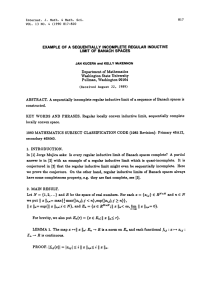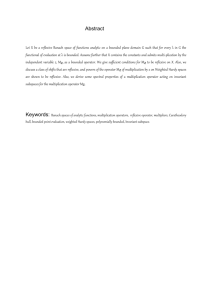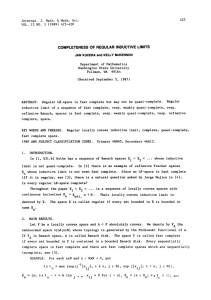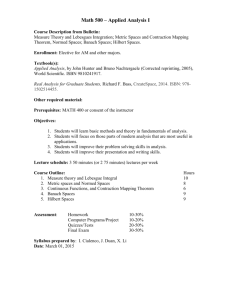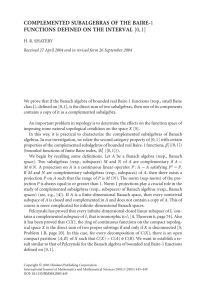Document 10440360
advertisement
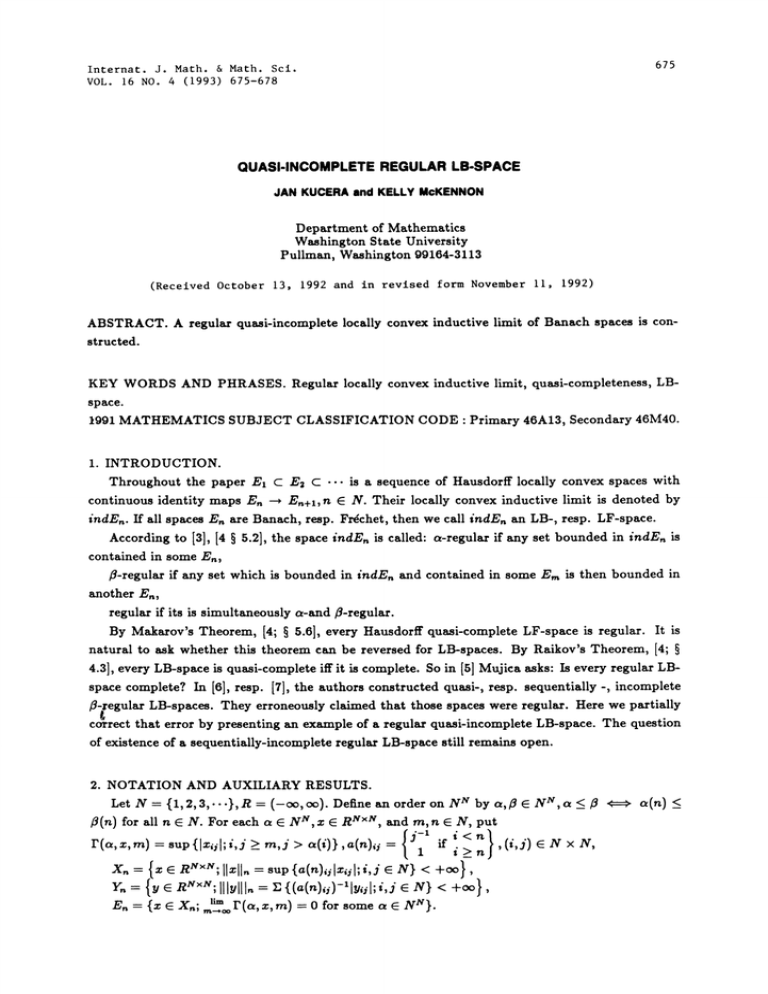
675
Internat. J. Math. & Math. Sci.
VOL. 16 NO. 4 (1993) 675-678
QUASI-INCOMPLETE REGULAR LB-SPACE
JAN KUCERA and KELLY McKENNON
Department of Mathematics
Washington State University
Pullman, Washington 99164-3113
(Received October 13, 1992 and in revised form November II, 1992)
ABSTRACT. A regular quasi-incomplete locally convex inductive limit of Banach spaces is
con-
structed.
KEY WORDS AND PHRASES. Regular locally convex inductive limit, quasi-completeness, LBspace.
1991 MATHEMATICS SUBJECT CLASSIFICATION CODE Primary 46A13, Secondary 46M40.
1. INTRODUCTION.
is a sequence of Hausdorff locally convex spaces with
Throughout the paper E1 C E2 C
continuous identity maps E --, En+l, n 5 iV. Their locally convex inductive limit is denoted by
indE. If all spaces En are Banach, resp. Frchet, then we call indEn an LB-, resp. LF-space.
According to [3], [4 5.2], the space indE,., is called: a-regular if any set bounded in indE,., is
contained in some E,
//-regular if any set which is bounded in indE,., and contained in some E, is then bounded in
another E,
regular if its is simultaneously a-and//-regular.
By Makarov’s Theorem, [4; 5.6], every Hausdorff quasi-complete LF-space is regular. It is
natural to ask whether this theorem can be reversed for LB-spaces. By Raikov’s Theorem, [4;
4.3], every LB-space is quasi-complete iff it is complete. So in [5] Mujica asks" Is every regular LBspace complete? In [6], resp. [7], the authors constructed quasi-, resp. sequentially-, incomplete
/3-,regular LB-spaces. They erroneously claimed that those spaces were regular. Here we partially
correct that error by presenting an example of a regular quasi-incomplete LB-space. The question
of existence of a sequentially-incomplete regular LB-space still remains open.
2. NOTATION
Let N
{1,2,3,...},R
(n)
rC,x,m)
for all
.
Y.
AND AUXILIARY RESULTS.
N. For each
sup{lx,l;i,j
{y ; Illylll.
{ x.;
(-oo, oo). Define an order on
a
NN
by
a, E NN,a
NN,z RNxN, d m,a N, put
m,j >
=(i)},aCn),
E{(a(n),i)-lly,il;i,J
v(,,)
0 to, o
_
{/-1 i<n},(i,j)NxN,
E
1
if
N} <
N}.
n
+},
= aCn)
J. KUCERA AND K. McKENNON
676
indX., Y projY., E indE.. Finally, we have an inner product
z,y
E N} defined on X. x Y.,n N, and on X x Y.
E{z,y,j,i,j
>=
<
(z,y)
>__ 1
LEMMA 1. For any sequence {a; k N} c N there exists a N such that m--liminf
for all k N.
PROOF. Put a(m) m{a(m);k m},m e N. Then a (a(1),a(2),...) h the required
For brevity we write X
a
property.
LEMMA 2. For each n N
(a) X, Y are Banach spaces.
(b) E is a closed subspace of X. Hence it is also a Banach space.
(c) X C X+, Y D Y+, and E c E+, where all inclusions are continuous.
PROOF. (a) Each X, resp. Y, a weighted -, resp. /-space, is Banach.
(b) x,,x e E, there e a,,a e N N such that r(a,, x,,m) 0,i 1,2. Then we have
i
F(a + a x + xz,m) 0. Hence x + x E, and
Let {x(k); k N} be a sequence in E with a limit x X. For each k N take a e N for
__> 1 for any
0. By Lena 1, there is a e N N such that mliminf
i 2’z.r(,.(),m)
a
.
kN.
Given an bitry > 0, choose k N so that [Ix- x(k)[[, < For this pticul k, te
m,,m e N sothat
> for anym_> m,, andr(at,x(k),m) < e for y m_> m. Finally,
put m0
m{m,m,n}. m mo then for i,j m,j > 2a(i), we have j > a(i) which
implies x(k),#l
r(a,,x(k),m). Moreover a(n),# 1 since
=m
a(n),#lx,#
’
x(k),#l + a(n),ilx(k)i/
[Ix- x(k)ll, + r(a,,x(k),m) < +
dx E,.
(c) For each (i,j)
.
Thus
r(2a, x,m) <
2
N x N, we have a(n + 1),
a(n),i. Hence ][x]]n+, ]Ix]In for any x e X
for
Ivll I+1 y V e Yn+l.
LEMMA 3. For each n N, let en > 0, B, {z E,; I111 <
d v be the convex hull of
U{B,; n N}. Then the closure of V in E is the same the a(E, Y)-closure of V.
PROOF. Let E be the dual spe for E. From the duality theo we know that is the same
the a(E, E’)-closure of V. Since Y c E we have a(E, Y) C a(E, E). Thus it remains to show
that v E is a a(E, Y)-limit of a net a v(a)- A V, then v is in the a(E, E’)-closure of V.
For eh a A, there exists re(a) N such that v(a) E{A(a,p)b(a,p);p 1,2,.-. ,m(a)},
d lyll
,
I
,
where A(a,p) > O,{A(a,p);p 1,2,...,re(a)} 1, d b(a,p) B,{,), 1’ n(a, 1) < n(a, 2) <
< n(a,m(a)). Take (i,j) e N x N. Let r be the lgest integer, less than or equal to re(a), for
which S, {A(a,p)b(a,p)i1;p 1,2,... ,r} [vi[. Denote the signum function by sgn and put
O,
Then le(,p),l
{x(,),(,);
()
Ib(,P),l for each p m() which
x,2,... ,m()} e V. Moreover
Iv, (),1
To prove (1) d
Iv, v(),l.
(2), we have to distinguish two ces:
r
+ 1 < p re(a)
implies e(a,p)
B.{,}
and
w(a)
677
QUASI-INCOMPLETE REGULAR LB-SPACE
x,2,... ,C)} <
mCct). Then IC),,I < {C,)lC,),l;
(b) r
{AC,P)lbC,P),, I;
Iv,y- v(),l.
1,2,... ,m()}
null sequences is contained in E and the identity maps
double
of
x
The Banach space co(N N)
x
x
x co(N x N)
Ez E are continuous. Hence the restriction of each f E’ to
co(N x N) is continuous. It follows from the Riesz-Kakutani-Hewitt Representation Theorem that
there exists a signed, regular, bounded, Borel meure g on the discrete locally compact Hausdorff
space N x N such that f(x) f xd,x Co(N x N).
Each x E is a pointwise limit, well a limit in E, of a sequence {x(k) co(N x N); k N)
tifying I(),l I,l... N. Hee it follow fom the Lebeague Dominant Theorem that
x(k)d
f(z())
xd. Since f(x(k)) f(x), we have f(x) f xd,x E.
v
The a(E, Y)-convergence implies the pointwise convergence. Thus, according to (2), w(a)
have
we
Domint
the
d
Lebgue
Theorem,
by
w(a)d
pointwise. Then,
f(w(a))
(1)
{A(,p)b(,p),;p
]
] d.
a
f(). f
’. =d
i i= th
LEMMA 4. Let be the
N ,(i,j) N x N,
poo,
c ()
(. ’)-or of
.
j
same closed neighborhood of 0 in
a r(,(l,l
in Lemma 3 and for each
e s,m e
0 fo
.
E
.
.
Let Vo {y e g;I < ,z >
,z e V}. Then the pol (Vo) in E is the a(E,Y)-closure
The polars V and
of V which, by the Lena 3, equals
in (E’,a(E’,E)) are equal. Hence
V
Thus
to prove that x(a)-z()
Vo
that
which
is
in
implies
(Vo)OO
Vo a(E’, E)-dense
holds, it sumc to show
,z(a) x() > [ 1 for all
Vo.
Choose ff N g so that if(n) > m{4,g},n N, and an arbitrary
Vo. Denote by {Yl
si== i b==d t, we hv I1
the element of Y defined by I1, I,1, (,J)
x
For eh n N, put
o
I<
d(n)
,,
,
{
, ()
o
.
o.
ifi=,j>(),j=2’forsomekN
0 otherwe
}
x } v{l,((),
IV{.((), (,),); (i,Y)
(),)I;Y > w(), } {1,,,1;2 > (), } {(dCi),,,)-ll,,,ldCi),,,; 2 > Ci),
} {(C)){l,.ldC),.;2 > C)}; N} {CC))l < Il.d() > I; }
q...
{C());i N} {C4’); } {2-’; }
wh
<
(,) >
,
MAIN RESULTS.
PROPOSITION 1. The net (3) is bounded in/ and Cauchy in/.
Proof follows from Lemma 4.
PROPOSITION 2. The net (3) does not converge in/.
PROOF. Assume x(a)
z in/. For each (i,j) E N N the functional z
z,. E R is
N N so that if(i) > j. Then
continuous. It implies x(a)ij --, zij. Fix (i,j) E N x N and choose
3.
-
"
J. KUCERA AND K. McKENNON
678
for x >
/, we
have
z(ct)i
Take a e N N and m
for any n N.
1 if j=2 forsomekEN
0 otherwise
z(/)i
N. Then for >_ m, 2 > a(i), we have 1
z,.2,
_
}
r(,., ). Hence z E
.
PROPOSITION 3. The space E is regul.
PROOF. Assume that E is not regular. Then there exists a set B bounded in E such that for
any n N either B is contained nd not bounded in E or BkE #
Choose x(1) E B,z(1) # 0, and (i(1),j(1)) E N x N so that Z(1),(1)j(1) # 0. Put e,
I(1),.#,1. Suppo that z(k),i(k),j(k), and ,k 1,2,-.-,n- 1, where n > 1, have been
selected. Then there e two ces" Either B c E. and B is not bounded in E. or there exists
x
BE.. h the second c=e I111. +. Hnce in either c=e there is z(n) B such that
I1(=)11 > -. m={.t; / 1,2,... ,n 1} and we can choose (iCn),jCn)) N x N so that
(4) la(n),.).#.)z(n).).#t.)l n. m={.t;/= 1,2,...,n- 1}. Put
min{’a(n),),()lx(k),),#()l; k 1,2,... ,n). Then
(5)
.
a
In ft, for p
r the inequRlity
Let a 0-neighborhood V be the
(6) follows from (5)
sine
d for p
<
r the inequMity
(4)
implies
.
in Lemma 3. Since B is bounded in E there ex-
w,re A,
Sy Ca), w
0,{,; 1,2,...,,} 1, V()
(P),C,,C,Iv(),C,.C,I
Ily()ll, <
(p),,.,l(),c,.,c,l, i imp]i IvCP),C,.C,I < I(),C,.C,I,P 1,2,...,,.
H I(’),,.,1
I’S{YC),,.,;P ,2,...,,}1 S{IvCP),,.C,I;P 1,2,.-.,,) <
1,
2,...,,} I(’),,,,1,
S(I,(’),,.t,I;
By combining all three Propositions we get:
THEOREM. The spe indE is a regular LB-space which is not qui-complete.
,,
REFERENCES
1.
KOTHE, G., Topological vector spaces I, Springer 1969.
2.
SHAEFER, H. Topological vector spaces, Springer 1971.
3.
MAKAROV, B.M. Pathological properties of inductive limits of Banach spaces, Uspekhi Mat.
Nauk 18
(1963),
171-178.
4.
FLORET, K. Lokalkonvexe Sequenzen mit kompakten Abbildungen, J. reine and angewandte
Math., Band 247, 1971, 155-195.
5.
MUJICA, J. Functional analysis, holomorphy and approximation theory II, North Holland
1984.
6.
KUCERA, J., McKENNON, K. Completeness of regular inductive limits, Int. J. Math.
& Math. Sci., Vol. 12, No. 3, 1989, 425-428.
7. KUCERA, J., McKENNON, K. Example of a sequentially incomplete regular inductive limit
of Banach spaces, Int. J. Math. & Math. Sci., Vol. 13, No. 4, 1990, 817-820.

